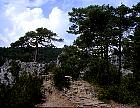Etymology: from Latin "Pinus"; Indo-European "Peak" = "bitter".
Origin: the indigenous species met in France are the Maritime pine, Pinus pinaster (native to the Western Mediterranean), the Scotch Pine or common Pine, Pinus sylvestris, the Umbrella Pine, Pinus pinea (in the characteristic form, in umbrella, native to the Mediterranean periphery), the Corsican Pine, Pinus laricio (and from Italy), the Swiss Stone Pine, Pinus cembra (native to the Alps and of the Carpathianses), the Pine of Alep (native to the Mediterranean periphery).
Other European pines are planted in parks and gardens, or in mountain:
- Pinus uncinata : in Fench "pine with hooks" holds its name of the scales of its cones. It is native to French mountains (Alps, Jura, Pyrenees). It is a survivor of the last glaciations. It appreciates siliceous soils or decalcified similar to the peaty soil (that appreciates the ferrugineum Rhododendron). It is planted to regenerate barren lands (to the right, Montpellier-le-vieux), notably to reafforest the Massif of Aigoual in theXIXth century (seedling of seeds on the snow). It was appreciated for the spirits of turpentine or balsam of the Carpathianses and for the manufacture of organs, thanks to its weak shrink. The frameworks of the military buildings of Mount-Louis, constructed under Louis XIV, are wooden in hooks and very well crossed centuries.
 - the Swiss Mountain Pine, Mugo Pine, Pinus Mugho, is the most ancient European pine, a survivor of glacial epoch (see this page also). It is a dwarf pine, which grows very smowly.
- the Swiss Mountain Pine, Mugo Pine, Pinus Mugho, is the most ancient European pine, a survivor of glacial epoch (see this page also). It is a dwarf pine, which grows very smowly.
- the Austrian Pine, Pinus nigra, is frequent in the north of France, but it suffers for some years the attack of a bacterium transported by the soil. Even the wood is not exploitable any more. It is threatened. The highest, in Paris, measures 32 m (small public garden of XVIth arrondissement).
Not European species: very many (from America, from China, from Japan).
Leaves: needles grouped in fascicles from 2 to 5. They form a cylinder; their cross-section is a semicircle for needles grouped by two (the most frequent case). The base of needles carries a fascicular sheath, which falls generally next autumn. Needles, they, persist 3 - 5 years.
Fruits: cones, which liberate winged seeds when they open in autumn. Cones need two years to get mature (seldom three years).
|

![]()

![]()

![]()

![]()

![]()

![]()